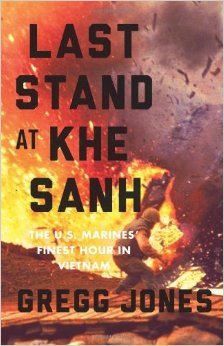
Try out our “Blind Date with a Book” for the month of February


 Last Stand At Khe Sanh: The U.S. Marines Finest Hour In Vietnam
Last Stand At Khe Sanh: The U.S. Marines Finest Hour In Vietnam
By Gregg Jones
Book Review-Daniel Kruse
In early 1968, LBJ and the nation’s military brass faced a dark dilemma: Would Khe Sanh become America’s Dien Bien Phu? The Battle of Khe Sanh was both a siege and a military confrontation. For North Vietnamese Army General Võ Nguyên Giáp, it was also meant to be a military as well as a psychological exercise; one that the North Vietnamese Army paid for dearly with unconscionable losses and very little gain.
The fight for Khe Sanh’s permanence commenced on Jan. 21, 1968 and lasted for seventy seven days. The Marines were indeed facing another Dien Bien Phu. The battle, posits Jones, “became perhaps the iconic confrontation of the Vietnam War.”
Khe Sanh, a remote U.S. outpost in northern South Vietnam, was surrounded by more than 20,000 well-armed North Vietnamese troops. Its defenders, 6,000 U.S. Marines, along with a detachment of U.S. Army Special Forces and a South Vietnamese battalion, were outnumbered three to one. Cut off from assistance by land, supplies and reinforcements would have to be delivered by air. This situation presented another set of problems: Enemy fire. The North Vietnamese fixed their artillery and gun sights on all the air approaches to Khe Sanh. American aircraft and helicopters now had to face a deadly barrage of fire on their closing approach.
In Last Stand at Khe Sanh, author Gregg Jones writes, “Most vulnerable of all were the four hilltop outposts guarding the northern approach to Khe Sanh—881 South, 861, 861 Alpha, and 558. They were entirely dependent on helicopter resupply, even for their water needs, and each arriving flight had become a magnet for North Vietnamese mortar fire. A chopper pilot had no more than thirty seconds to land, offload, take on medevac cases, and get off the LZ before the first rounds hit.”
Though the North Vietnamese threw lock, stock, and barrel at Khe Sanh’s fearless defenders, including infantry, mortars, heavy artillery, tanks, trenches and even tunnels, the Marines and their co-defenders responded accordingly, even fighting with knives and rocks on one occasion when their ammunition was depleted.
Despite the heroics and the Marines’ superb combat skills, disaster beckoned. The Pentagon considered the use of chemical and nuclear weapons to neutralize the enemy. President Johnson finally declined, in hopes that the Marines could hold out. He knew that the loss of Khe Sanh would further damage his presidency and fan the already luminous flames of opposition to the war. At one point, Johnson lays down the bottom line at a meeting with his national security team: “Frankly, I am scared about Khe Sanh. I have a mighty big stake in this. I am more unsure every day.”
One amazing factor concerning the defenders of Khe Sanh was their vast diversity and backgrounds. There were those with college degrees, high school dropouts, grizzled Korean War veterans, and teenage boys fresh off the farm. Where Jones writing really shines, and where much of the book is centered, is in the descriptions of the soldiers early backgrounds along with their boundless courage in the face of horrific combat.
In an emotional epilogue Jones also follows some of the defenders after Khe Sanh is saved and then abandoned. Readers learn of their trials and travels, their battles with PTSD and survivor’s guilt, chemical dependency, and finally, reconciliation and reunification via reunions at the Vietnam Veterans Memorial and Arlington National Cemetery.
Jones is an accomplished writer who has traveled the world covering military events in Sri Lanka, Cambodia, India and the Philippines. Last Stand At Khe Sanh brilliantly covers the lives of a group of men who, as Jones writes, “found a kinship that transcended a nation’s bitter divisions, and with their blood, toil, and tears, they earned a place of honor in American history.”
Beverly Deepe Keever
Book Review by Daniel Kruse
The large panoply of literature on the Vietnam War is wide and varied. Death Zones and Darling Spies by Beverly Deep Keever is definitely a work that will be discussed in historical circles for many years to come. Keever was, for lack of a better term, a journalistic trendsetter.
Fresh out of the renowned Columbia Journalism School in 1961, along with a master’s degree and letters of introduction to A.P. bureau chiefs in Asia, Deepe, then 26, embarked on a trip around the world. She allotted herself two weeks in South Vietnam. Seven years later, she was still there, in addition to having earned the distinction of being the longest serving American correspondent covering the Vietnam War. She also earned a Pulitzer Prize nomination in the process.
In Death Zones and Darling Spies, Beverly Deepe Keever describes what it was like for a Nebraska farm girl with humble beginnings to find herself halfway around the world, while trying to make heads and tales of one of the nation’s longest and bloodiest wars.
Arriving in Saigon as Vietnam’s war entered a new stage involving American helicopter units, provincial advisers, and cookie-cutter ambassadors, she tells of trips from her Saigon apartment to jungles where American frontier-styled forts initially dotted Vietnam’s borders, only to fall like dominoes from communist attacks seven years later.
In1965 she travelled with American combat units, braving elephant grass and the jungle, while witnessing their unprecedented technology and courageous valor, along with their inability to distinguish peasant farmers from come-and-go guerrillas.
While Lyndon Johnson pondered the beginnings of The Battle of Khe Sanh and declared in his deep Texas drawl that, “I don’t want no damn Dien Bien Phu,” Keever opted to head for the besieged base and covered the vicious fighting that continued for seventy-seven days.
Keever’s large collection of memos to editors, along with published and unpublished dispatches for New York and London newspapers and magazines, supply the reader with time machine descriptions of Buddhist demonstrations and numerous coups, both fake and genuine.
Two Vietnamese interpreters, self-described as “darling spies,” helped her navigate Vietnam’s darkly shadowed world and below-the-surface war. These memoirs, both personal and cycloramic, describe the nightmare visions of war, along with Americas rise and descent of power and status.